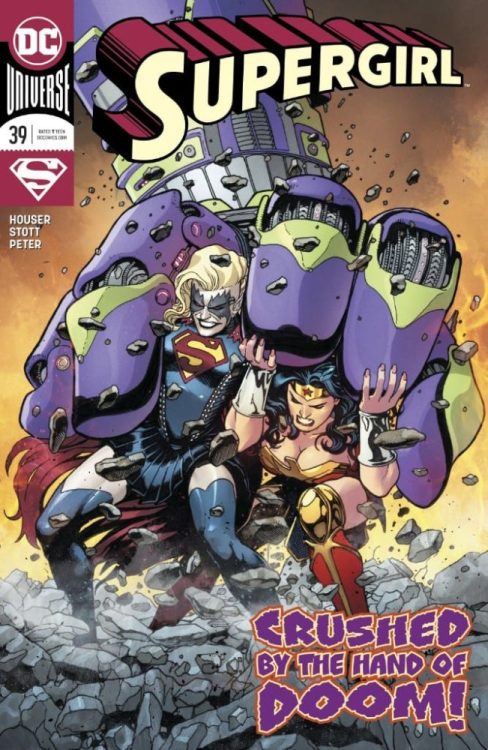Towards the end of 2019 a new writer and artist took over duties on DC Comics Supergirl. Jody House and Rachael Stott have a track record of producing wonderful work, especially together, so the scene was set for a fun, intensive run for the Last Daughter of Krypton.
When their story finally started in issue 37 it wasn’t the spectacular I expected. In fact, I would go as far as saying it was a disappointment, although not necessarily because of the work that Houser and Stott were doing. The plot revolves around an ongoing DC Universe event and has Kara infested with the Batman-Who-Laughs virus. The following four part story entitled I’m The Bad Guy pits Supergirl against a number of other DC heroes in a less than original story.
The narrative takes four full issues of Kara fighting for her to realise that the virus is in control of her and then the conclusion takes place in a separate comic. On the surface it was unimaginative despite some visual flair and witty scripting.
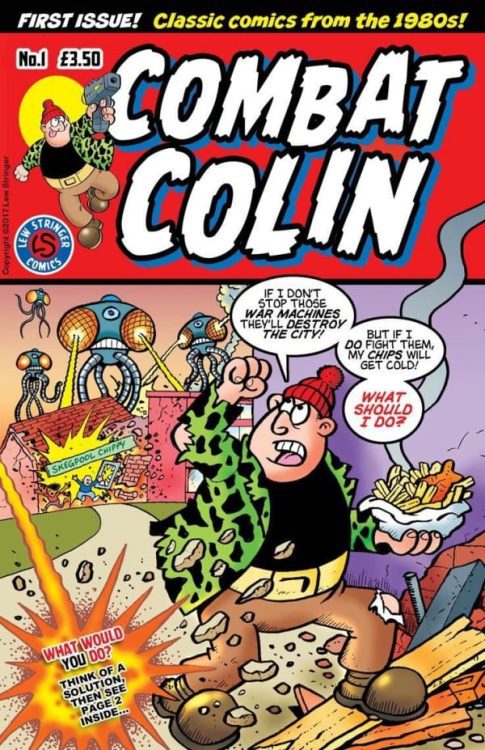
All Change
But then lockdown. The international pandemic has affected everyone and changed day to day living. One of the outcomes, personally, is that I am re-reading a lot of comics that are kicking around in my home. It was while reading one, random comic, that I gleaned a new perspective on the Houser/Stott Supergirl run. Something in the UK strip comic Combat Colin by Lew Stringer made me re-assess how I should have been reading Supergirl.
In an essay published in Critical Approaches to Comics published by Routledge in 2012, Joseph Witek discusses modes of comics. He posits that there are two traditions in visual representation for modern comics; The Cartoon Mode and the Naturalistic Mode. The former deals in caricature, expressiveness over realism, and the interpretation of the world through exaggeration. The later creates a ‘realistic’ world for the characters to live in with some form of grounding to explain how the world works. This often takes the form of realistic artwork with complex and detailed scenery or characters.
One is often seen as more serious than the other but this is a misnomer as comics fitting under The Cartoon Mode often deal with complex matters of politics, relationships, sexuality, and violence. The Underground Comix scene had a large influence on the ‘darkness’ that took over superhero comics in the late 80’s because the instigators of that movement, people like Alan Moore and Frank Miller, came out of an environment rich with self published comics and pulp noir novels.
But what has this got to do with Supergirl and who is Combat Colin?

Everyman Colin
If you grew up in the UK reading Transformers or Action Force comics you will know and love Combat Colin. For those who didn’t, he is a down to Earth street hero who has some super strength and a sidekick named Steve. The character was created, written and drawn by Lew Stringer. At first in a single row strip before blooming into a half page, or even full page, gag comic.
The character and the strip is charming and funny, even after 30 plus years since its creation. Although there isn’t much continuity within the stories, occasionally a number of strips would build up to form a larger story. One such story introduced an arch nemesis for Colin in the form of The Brain; a super intelligent alien and ruler of an underground domain. The references to Superhero comics, such as the Fantastic Four, are obvious but there is a lot more going on in these short strips.
Stringer uses Combat Colin to parody mainstream comics, riffing off of established characters and tropes to create absurd situations. However, the reading can be taken a step further. Stringer uses the Cartoon Mode of comic representation to poke fun at the society he lives in. In The Brain story, for example, the masterminds plan is to ultimately control Humans by turning their brains to custard via boring television shows. Through the control of programming, The Brain is able to fill the homes of the UK with endless drivel like Game Shows and Soap Operas.
This comical dig at the state of British television highlighted a growing concern that the dumbing down of television would lead to an less engaged audience. It is clear from the comic strip that Stringer believed this was possible and depicted it as a travesty that must be stopped. Stringer’s fight wasn’t against television but a lack of imagination, something that he has in spades.
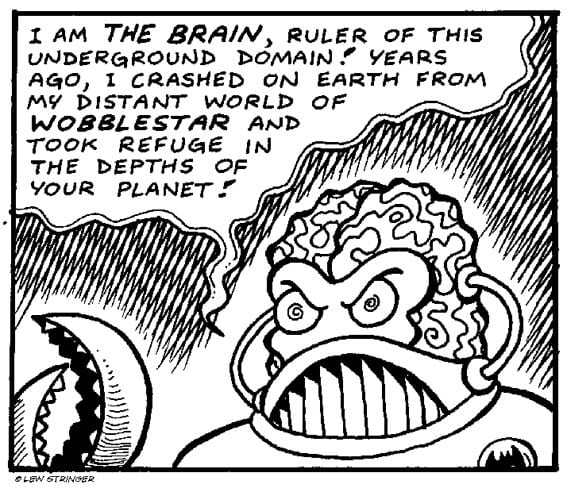
Complex Characters
The other aspect of the comics that I noticed more with a re-read is the complex personalities of the characters. Initially they seem like two dimensional caricatures with a boldness that matches the artwork. This was perfectly acceptable to the young teen version of myself as I read through the Transformers comics, but in retrospect I can see Stringer working in layers.
The heroes have one goal and are determined to save the day at all costs: true hero qualities. But they are also flawed. They wear their fear openly in their reactions, “I want my mummy,” screams Colin when he comes face to face with a grotesque alien creature. His bravado melts away as his sidekick turns in an attempt to escape the panel. Colin reacts in a way that most people would react, not like the Superheroes in the comics that Stringer is sending up, but with realistic panic and desperation.
The villains of his story are equally interesting. The Brain has as many facets to his personality as Colin or Steve does. He is offended by being called a monster, a reference to the creature from Frankenstein, and he has created life and wishes to care for it. He also has a backstory that is familiar to any readers of DC comics, as it closely resembles that of Superman and Supergirl. Lost in space, separated from his own kind and marooned on a world that could not accept him.
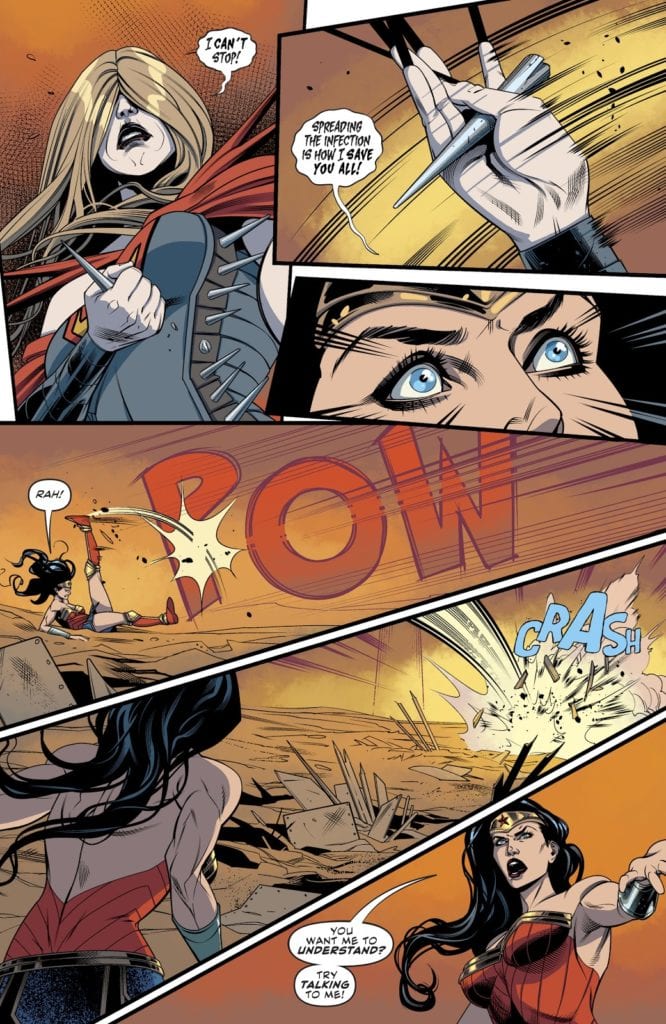
And Now Supergirl
It wasn’t, however, The Brains backstory that made me link Combat Colin with the current run of Supergirl. Instead, it was the style in which the story was being told. To compare the two you would instinctively find little similarity between them and you would definitely not say that they are working to the same modes of storytelling. As a general rule DC comics would fit Witek’s Naturalistic Mode perfectly by creating a realistic world for their superheroes to live in. The artists more often than not strive for realism, and there appears to be a house style to this effect.
In issue 37, the first of Stott’s Supergirl run, it would appear that the artist is continuing this approach to the comic. The characters are fully realised and the scenery is highly detailed giving the reader a clear sense of their surroundings. However, as the story continues into part 2 and most notably in parts 3 and 4, the style begins to change.
Stott does not alter her rendering of the characters very much although they do seem to become more stylised, more like caricatures of the superheroes they represent. Instead she takes a leaf out of The Cartoon Mode of representation and reduces the scenery. The backgrounds become empty landscapes with the occasional building required for plot reasons. The sense of location is lost as the focus shifts to the concepts of the characters fighting.
The emphasis of issues 39 and 40 is not the DC Universe; it is not the larger narrative beyond these pages in previous or future issues; it is not even the fight that is happening between Supergirl and Wonder Woman. Houser and Stott want the reader to focus entirely on the struggle that is happening within Supergirl, the fight between Kara and the Batman-who-laughs virus. The reality of the world slips away as the focus on personality takes over.
Just as the Combat Colin strips contain layers of character within simple, broad strokes of art, so too does Stott’s Supergirl. The physical fight becomes ridiculous, as illustrated by the ever changing ‘metal’ costume that Supergirl wears. The interaction between Wonder Woman and Supergirl becomes a parody of superhero punch ups. Through it all, however, is the psychological battle, the hinted at struggle, and the depths that the reader has to find for themselves.
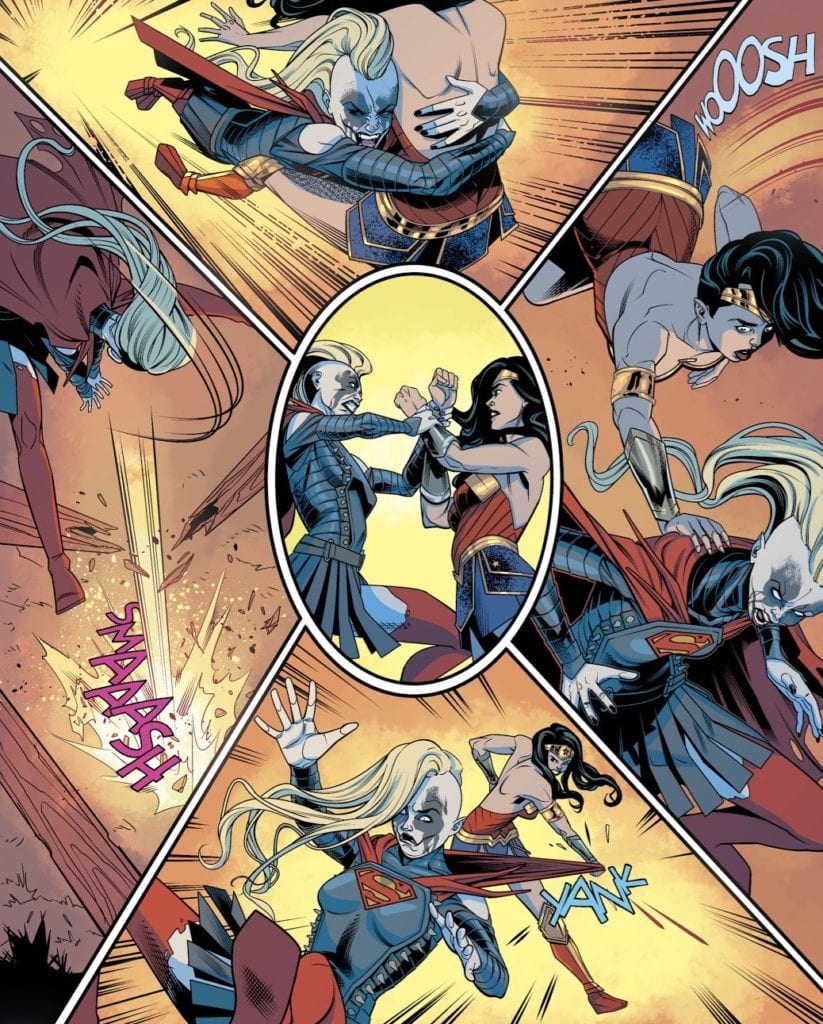
Conclusion
By reading through an event story that features in a number of different titles, it is easy to become lazy in your reading. Especially if that event is in one of the two big publishers because a certain house style is expected and therefore you automatically adjust yourself to a particular frame of reading. This can cause issues if something a bit different is thrown into the mix.
With Houser and Stott’s Supergirl an element of realism, grounded in the DC Universe is to be expected because, as I have shown, the usual approach to these comics is Witek’s Naturalistic Mode. However, this version of Kara’s adventures leans more heavily into a Cartoon Mode, taking a more metaphysical route into the narrative. Stott chooses to forgo the complex visuals required to tell a realistic story and creates an abstract setting for larger than life characters. Reading the story through from issue 37 to issue 40, you can clearly see that the art style changes, dropping further away from reality as Kara’s struggle intensifies. The entire story-line is a visual metaphor for Supergirl’s journey while infected and, just as the story becomes more ridiculous, the art adopts an expressionistic style.
The lesson here, and one that I have learned, is not to judge a comic by its predecessors or current partners. The scope, even within a DC Comics event, for different styles and modes of storytelling is massive. Sometimes it is important to look past expectations and to embrace these different modes of storytelling.
I may still have some problems with the narrative of the current run of Supergirl but by applying a different mindset to my reading I can appreciate much more what the creators are doing.
Are there any comics you are reading that you are seeing in a new light? Let us know in the comments below.

